Imagine the scenario: you set out on your favorite hike in early spring, excited that the long winter’s snow has finally melted.
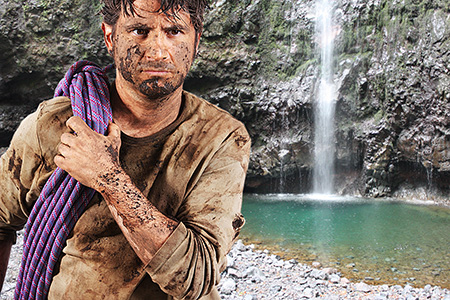
But you trip on a patch of lingering ice along the way, spraining your ankle. Or you set out to reach the summit in early autumn, forgetting that now the sun sets much more quickly. On your way back, you lose the main trail and find yourself scared and alone. Even the most experienced hikers and outdoor enthusiasts can make mistakes that cause injury or cost them their lives. Regardless of whether you’re a novice outdoorsman or a seasoned pro, it’s important to be prepared when you’re out, as anything can happen on the trail. Without survival knowledge, you’re out of luck.
So what do you need to survive in the wild?
From dealing with losing the trail to building an adequate shelter, these basic survival skills will keep you safe when the unexpected strikes.
Building a Sound Shelter
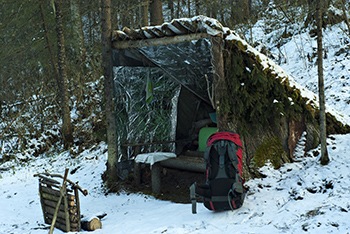
In many places, whether you’re in cold weather or hiking in summer, the nighttime temperature can drop far below the daytime high. Add in the fact that you might be cold, sweating, and tired by the end of the day, and the effect of a dropping temperature becomes much worse. In cold weather, the onset of freezing temperatures is especially perilous. Without adequate supplies, like a solid shelter to block the wind and a space blanket to stay warm, you’re at a high risk of developing hypothermia and eventually freezing to death. Ideally, you should have a south-facing door and build a sturdy wall against the wind, which generally comes from the north or west. If you’re stranded in the desert’s searing sun, build a roof over your head to block the sun’s scorching rays.
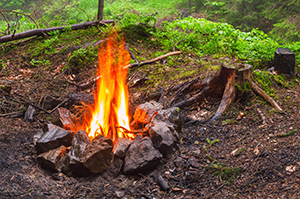
Lacking a Fire
While building a fire is a lost art in much of the modern world, it’s one of the essential basic survival skills when you’re trying your hand at wilderness living. Before you head out on a hiking or camping expedition, learn the basics about building a fire. And wherever you go, bring along waterproof matches, which are quite often the only thing that will help you out in cold, rainy conditions.
Calling for Help
You’re injured. You’re tired. You’ve lost the group. Whatever your emergency situation is, there are times when you simply cannot call for help. Unless you have a strong signal like a GPS watch or a loud whistle, your cry for help can literally get lost on the wind in the wilderness. Before you set out, there are many great manmade items that you can use to signal for help, ranging from sophisticated watches to flares. Out in the wild, use fire, snow, strips of bark, or anything else you can find to create evidence of human life in the area.
Drinking Dirty Water
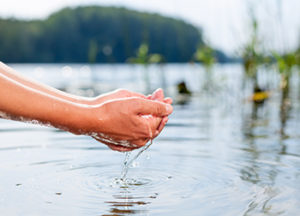
While you might think nothing of turning on the tap and getting fresh, clean water to drink, the availability of a fresh drinking source is often sorely lacking in the wilderness. What makes matters worse is that even healthy and fit hikers can succumb to waterborne illness. Knowing how to purify snow or rainwater is one of the most essential survival skills that you can have. If you have matches and a small cooking pan, you simply need to just bring snow or a fresh water source to a boil. Then, and only then, will it be safe for you to drink. If you’re near a good water source, try to collect as much from that spot as possible, since you have some assurance that you’re not drinking filthy or contaminated liquid. If you can, try to purify extra amounts of liquid for future use.

Improper Clothing
When you’re out in the wilderness, a general rule of thumb is that you can expect the unexpected to happen. Just as when you’re out exercising, it’s possible to break a sweat as you’re climbing a mountain or wearing a heavy pack. This is fine, and normal, but problems arise when you stop moving or get chilled. It doesn’t take long for deep chills or hypothermia to set in, quickly creating an emergency situation. Before leaving, dress in layers, and bring along extra supplies, including handwarmers, socks, a space blanket, and gloves in case your clothes get wet. Even if the weather forecast calls for sunny skies, pack a rain coat. Another reason why it’s good to plan ahead is that if you get lost, you’ll have more clothing in case you get stuck on the trail for longer than anticipated.
Not Using Navigation Tools

These days, you can jump in your car and use your GPS navigation to get from Point A to Point B. But when you’re out on the trail, your sophisticated modern equipment might not work. By all means, bring along your cellphone and GPS watch for comfort and assurance. But if they don’t work, plan to have a compass for backup. It also helps to learn basic trail markers that can indicate if you’re heading in the right direction.
Miscalculating Risk
After seeing Bear Grylls on television, you too might think that you’re invincible and capable of conquering any terrain Mother Nature throws your way. But the reality is that if you set out unprepared, no matter how experienced you are, even the most normal experience can turn into a disaster. Therefore, it’s always wise to plan for the unexpected when you’re out.
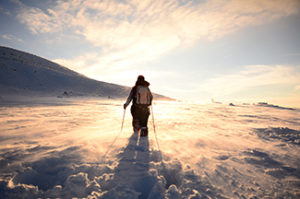
Failure to Make a Plan
Some hikers leave home on a Saturday morning thinking that they’ll just be out for a few hours. Others head out on their favorite trail alone and unannounced, hoping for a brief reprieve from the work week’s stresses. Sadly, these cases can end in tragedy. If no one knows where you are and when you left, they’ll have no clue where to start looking when they realize you’re missing. Even if you want your weekend hike to be an escape, leave your contact information, planned route, and date of travel with the park service at the trailhead.
Being Caught Unprepared
Rain, snow, ice, and fog can set in very quickly – and unexpectedly – when you’re out on the trails. If it’s summertime, you can add thunderstorms with dangerous lighting, strong winds, and damaging hail to that list, too. Another rule of thumb when you’re outdoors is that anything can happen. A stray shower or thunderstorm can suddenly appear on a beautiful summer day, and a freak snow squall can arrive without warning in spring. So before heading out, plan and pack accordingly by packing extra survival gear for unexpected conditions.
Not Stopping to Rest

If you’re ambitious, or if you are merely scared and wanting to hike nonstop to look for help, it’s easy to overdo it. And while it is tempting to forge ahead searching for that rescue team or the next campsite, it’s best to slow down and take a break. This is especially true if you’re low on food and water supplies. In addition to conserving precious energy, another advantage of stopping to rest is that if you’re in one place, it’s easier for search and rescue crews to find you.
What do you need to survive in the wild? Whether you’re tackling the Appalachian Trail, Mt. Rainier, or a trail near home, anything can happen. From getting caught in a surprise snowstorm to taking a wrong trail and having to camp out unexpectedly overnight, things can and do go wrong when you’re attempting wilderness living. By knowing these survival skills, you’re in a much better position to handle – and survive – whatever comes your way.


